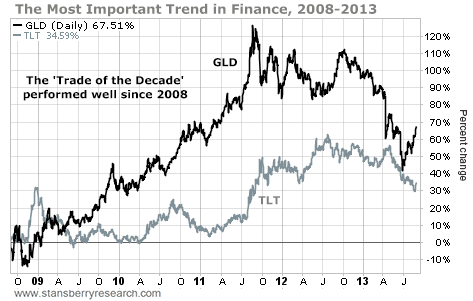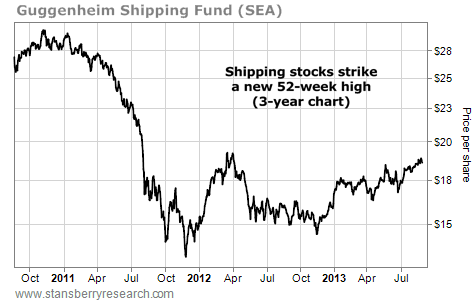| Home | About Us | Resources | Archive | Free Reports | Market Window |
The Easiest $100 Bet in All of FinanceBy
Wednesday, August 28, 2013
I'd like to start with a simple question.
This is something anyone who knows anything about the stock market should be able to answer without even thinking about it:
What was the better investment in the raging bull market of 1980-2010, stocks or bonds?
Most people know that the U.S. stock market enjoyed a massive, 30-year bull market after 1980. Stocks went up nearly every year. So if I asked you, what made more money between January 1, 1980 and December 31, 2009? Stocks or bonds? You would almost surely answer "stocks."
You'd be wrong. And if you don't think carefully about why... and the ideas I'm going to share with you today... you're likely to get wiped out financially over the next several years.
If you learn nothing else from me this year, at the very least, learn this...
Stocks did do well over the 30-year period from 1980 to 2010. If you simply bought the S&P 500 and reinvested your dividends, you made 11.3% per year, for a total return of 2,676.8%.
But if you had invested in the U.S. Treasury's long-dated, zero-coupon bonds, you would have done much, much better.
According to financial writer Gary Shilling's research, buying 30-year zero-coupon U.S. Treasury bonds each year and rolling them over annually would have made you more than 19% annually during the period, for a total return of 24,879%.
If you want to make a lot of easy money off your friends who consider themselves financially smart, just offer them a $100 bet on whether or not stocks or government bonds made more money for investors during the great bull market of 1980-2009.
You'll likely win every time.
Buying long-term U.S. government bonds (that had no risk of default) and simply reinvesting the profits annually would have earned you considerably more money than buying stocks in the 30 years following 1979.
And in 1979, just as the big bull market in U.S. Treasury bonds was about to begin, what did investors think of the bond market?
One of the world's greatest investors, Warren Buffett, wrote in his 1979 letter to shareholders that long-term bonds were "obsolete." Buffett didn't believe the market for long-term bonds would even exist by the time the government's newly issued 30-year obligations reached maturity...
In fairness to Buffett, Paul Volcker wasn't appointed to the Federal Reserve until August 6, 1979. His opinion on long-term bonds probably changed as Volcker's policies began to rein in growth in the money supply, causing inflation to subside and sparking the massive bull market in bonds. But the point I'm making is important: The big moves in markets – the giant, long-term "secular" changes – occur when there is a nearly universal agreement regarding a financial asset's appeal.
Back in 1979, long-dated U.S. government bonds could not have been more loathed. People called them "certificates of confiscation." And no one – not even the "Oracle of Omaha" – recognized the greatest investment opportunity of our lifetimes in front of them.
Last year, the yield on the U.S. Treasury benchmark bond – the 10-year note – hit a modern, all-time low of 1.55%. That is, if you believed the market's price, investors were willing to lend the government $1,000 for the next decade and only receive $15.50 per year in interest.
Yes, you have good reason to doubt that this is a real interest rate, because the Federal Reserve has been purchasing all of the government's newly issued debt – $85 billion worth a month. As a result, we don't know what the free-market interest rate would be for our government's obligations. But it's a safe bet that "higher" is the correct answer.
Back in January 2009, I warned that the trend toward lower interest rates (and higher bond prices) couldn't possibly continue. I said we were sitting on the verge of a massive shift higher in interest rates. Here's what I wrote:
Since then, our federal government's spending habits and debt accumulation have become significantly worse. The government's total debts have increased 70% in only four years – a truly stunning and nearly unbelievable increase. And despite any major war or financial crisis, we continue to run annual deficits of around $1 trillion. Last May, I saw something in the market I literally couldn't believe: Junk bonds were trading at prices that reduced their benchmark yields to less than 5%. I wrote at the time that this had to be the top in bonds because default rates alone would wipe out all the gains that were possible by buying a portfolio of junk bonds at those inflated prices.
And so... just as the investment community was overwhelmingly bearish on bonds in 1979, just prior to their greatest bull market in history... the market became more bullish on bonds in May than it had ever been during my lifetime – just as we hit a low point in their yields.
When I began warning in 2009 about the inevitable collapse of the U.S. bond market, I couldn't have foreseen the Federal Reserve's massive intervention. The central bank has bought about $3 trillion worth of bonds over the last four years.
But as it began to do so, I recommended a simple way to protect yourself from this incredible folly... and also a way to judge our progress toward a financial apocalypse. I called it the most important trend in the world.
All you had to do to monitor this trend was compare the price of the long-term U.S. Treasury bonds with the price of gold. A simple way to do this was to watch the prices of the iShares Barclays 20+ Year Treasury Bond Fund (TLT) and the SPDR Gold Shares Trust (GLD).
My reasoning was simple: Printing money doesn't create value, it just creates inflation. By manipulating the bond market, the Fed could force interest rates lower (and bond prices higher). But sooner or later, that bubble would burst, most likely triggering a massive inflation. As people began to hedge against this growing risk, the gold price was sure to rise.
If you'd done nothing else over the last five years, but simply sold the long bond short and bought gold, you've done pretty well. Here's the five-year chart of the two positions. As you can see, gold has outperformed the long bond by about 50% over the period.
 Interestingly, though... this simple hedge stopped working over the last two years after gold investments became popular... The gold trade had become too "crowded."
Over the last two years, the long bond has done better than gold. Markets don't move in a straight line.
But today... my "trade of the decade" is working again. It's working because gold's recent correction has driven much of the speculative excess out of the gold price. And the trade is working again because the Fed is being forced to withdraw its support from the bond market.
We're about to find out what the real price of bonds should be... something that's sure to be extremely painful for the mass of investors who've come to believe bonds will never fall.
My advice? Beat the crowd. Sell the long bond. Buy gold. Sit tight.
Regards,
Porter Stansberry
Further Reading:
Porter's been following the U.S. bond-market bubble for years. He thinks it's "without a doubt the single greatest threat to your wealth you will ever face." And for those who don't own gold, "it could soon be too late." Catch up on Porter's commentary here, here, and here.
Dr. David 'Doc' Eifrig has showed DailyWealth readers how powerful it can be to hold chaos hedges – like gold – in your portfolio... "When investors get nervous about bad economic news... debt crises in Europe... and the specter of runaway inflation in the United States," he writes, "stocks fall, and gold and silver rise." Learn how Doc protects his wealth with precious metals here and here.
Market NotesAN IMPORTANT BULL MARKET YOU'RE NOT HEARING ABOUT Despite lots of negative economic news, shipping stocks are enjoying one of the most important bull markets you're not hearing about.
Several weeks ago, we noted how shipping stocks are a useful way to monitor the global economy. They rise and fall with demand for things like iron ore, oil, grain, and manufactured goods.
A useful way to track this idea is with the Guggenheim Shipping Fund (SEA). This fund's constituents haul raw materials and finished goods across the world's oceans. The world's largest container ship operator, Maersk, is the fund's largest holding.
Overcapacity and a sluggish economy kept this fund in the dumps during 2011 and 2012. But as you can see from today's chart, SEA is recovering. In just the past week, it reached a fresh 52-week high. This is a key bull market almost no one is talking about.
 |
In The Daily Crux
Recent Articles
|


